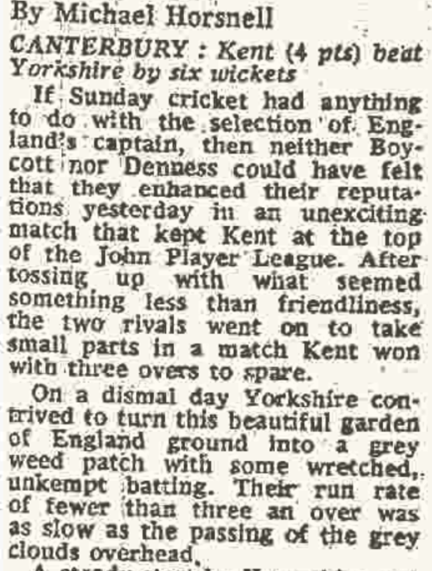This week in
1975 was given over to one-day cricket, with the final two rounds of the zonal
stage in the 55-over competition and the Sunday League. Again, the scoring was
generally as modest as a Jane Austen heroine. Minor Counties (North) were dismissed
for 67 (Nottinghamshire’s left-arm quick Barry Stead five for 26), MC (South) for
94 and 83, Oxbridge for 93. Worcestershire fell 49 short of Northamptonshire’s 152.
Another left-arm seamer tending to the portly, John Dye with five for 30, was
central here too.
At Lord’s, Kent
made just 137 for nine in 55 overs, of which John Shepherd contributed 96, a
Bannermanesque[1]
proportion of the total. Otherwise, only Underwood made double figures. Shepherd
came in unusually high at No 5 here, which is where he would have batted
regularly for most counties rather than his perennial No 8 for Kent. There are
any number of similar examples of Shepherd making runs when others failed. His
three for 21 ensured that his runs were just enough for Kent to win. No player
contributed more to Kent’s success in the seventies than John Shepherd.
Alan Gibson
was there. I do agree with him that low-scoring one-day games are the most interesting
kind. It is a measure of the financial development of the game in the subsequent
half-century that now it is the fast bowlers who break down. Then it was their
cars.
Later in the
week Gibson was at the Oval for Surrey versus Gloucestershire, which meant that
he was sure to report on the performance of one of the main players in his
repertory company, Robin Jackman aka the Shoreditch sparrow.
Jackman was a magnificent appealer, quite the best of his generation. With a noise sometimes mistaken for a passing aircraft he would turn, throw his arms in the air and continue backwards down the pitch, finishing close enough to the batter to shake hands, this after a run up double of the length that the subsequently generated pace suggested it should be. That his dash to the boundary did not prevent an all-run four was no shame; the Oval field in those days was vast, barely contained within a single postal district.
In a
footnote to Gibson’s account it was reported that in the 52nd over of
Surrey’s reply umpire Peter Rochford failed to add an extra ball to the over
for a wide. The match finished with the scores level but with Gloucestershire the
winners having lost fewer wickets. These days, even in a non-televised match, such
an error would be picked up by the match referee and communicated to the
middle. In the past, counting mistakes were more frequent than might be thought,
and, like other umpiring decisions were more widely accepted as part of life’s
rich tapestry.
At
Chelmsford, Brian Edmeades of Essex was caught on the boundary, but fielder Roger
Marshall told the umpires that he could not be sure that both feet had remained
inside the boundary (I’d bet that it was marked by a painted line rather than a
rope). Edmeades was reprieved, and was unbeaten at the end of the innings. When
the numbers were crunched at the end of the day that one wicket enabled
Middlesex to qualify for the quarter-finals at the expense of Sussex. Perhaps Sussex skipper Tony Greig had
renounced the law of the jungle as urged by John Woodcock (see last week).
More slow scoring in the Sunday League. I was at Canterbury for the visit of Yorkshire, another game that fails to register in the memory, but the scorecard attests that I was there.
The Times reporter was Michael Horsnell, at the beginning
of three decades as a staff reporter. He covered crime and other issues rather
than sport, possibly the result of his experience at St Lawrence that day.
Derbyshire
had a bad week. On Saturday they lost to Lancashire by 67 runs. “Since for them
any total over 150 constitutes and unseemly run orgy, it was clear that Derbyshire
would have to rise above their usual mundane level with the bat to win” wrote
Derby-based reporter Michael Carey (later to be come cricket correspondent of
the Daily Telegraph). Later in the week Brian Bolus resigned as skipper,
to be replaced by Bob Taylor.
Trawling the
archives provides a reminder of stories that took up a lot of space at the time,
but are now forgotten. One of these was the question of whether Montreal’s the
new Olympic stadium would be ready for the 1976 summer games. Such was the
level of doubt that this week Mexico City offered to dust down the 1968 stadium
as an alternative.
The upcoming
referendum on membership was the biggest continuing story. Like referenda on
anything, the protagonists presented their view as the universal elixir while
the truth lay ignored halfway between them.
[1] In what is now regarded as the first test match Charles Bannerman, who faced the first ball, went on to make 167 out of a total of 245, which remains the highest proportion of an innings contributed by one batter in a test match (67.35%). Shepherd’s innings was 70.07% of the total.





No comments:
Post a Comment